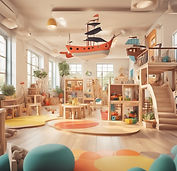Ideas for Creating an Engaging and Efficient Daycare Setup
How do I effectively set up my daycare?

Creating an Engaging and Efficient Daycare Setup: Ideas for Directors
Setting up a daycare center involves careful planning and creativity to create a safe, engaging, and educational environment for children. As a director, your goal is to balance functionality, safety, and aesthetics to foster a nurturing space. Here are some specific and creative ideas across different categories to help you design the perfect daycare setup.
1. Classroom Layout and Design
Flexible Learning Zones: Create distinct zones for different activities such as reading, arts and crafts, sensory play, and quiet time. Use rugs, shelves, and low partitions to define these areas.
Interactive Walls: Install interactive wall panels with activities like magnetic boards, felt boards, and sensory boards. These can be changed periodically to keep the children engaged.
Natural Elements: Incorporate natural elements such as wooden furniture, plants, and natural light. These elements create a calming environment and teach children about nature.
2. Furniture and Storage
Multi-Functional Furniture: Use furniture that serves multiple purposes, such as storage benches, convertible tables, and foldable mats. This saves space and adds versatility to the classroom.
Accessible Storage: Ensure that storage units are child-friendly and within reach. Use clear bins with labels and pictures to help children identify and organize their belongings.
Ergonomic Seating: Provide child-sized ergonomic chairs and tables to ensure comfort and proper posture during activities.
3. Outdoor Play Area
Natural Playground: Design an outdoor play area with natural elements like sand pits, water tables, garden beds, and climbing structures made from logs and stones.
Adventure Zones: Create themed zones like a pirate ship, a fairy garden, or a construction site with materials that inspire imaginative play.
Interactive Garden: Set up a small garden where children can plant, water, and watch their plants grow. This hands-on activity teaches them about nature and responsibility.
4. Learning Materials and Activities
Rotating Activities: Regularly rotate toys and learning materials to keep the children’s interest. Introduce seasonal themes and culturally diverse materials to broaden their horizons.
STEM Stations: Set up science, technology, engineering, and math (STEM) stations with age-appropriate experiments and activities. Use simple materials like blocks, magnets, and measuring tools.
Cultural Corner: Create a cultural corner with books, artifacts, and costumes from different cultures. This encourages children to learn about and respect diversity.
5. Safety and Hygiene
Safety First: Install safety gates, corner guards, and non-slip mats. Ensure that all electrical outlets are covered and hazardous materials are out of reach.
Sanitation Stations: Place hand sanitizing stations at key locations such as the entrance, dining area, and bathroom. Teach children the importance of hand hygiene.
Easy Clean-Up: Use washable and durable materials for furniture and play areas. Ensure that cleaning supplies are easily accessible for quick clean-ups.
6. Technology Integration
Smart Boards: Incorporate smart boards for interactive learning sessions. These can be used for educational games, videos, and virtual field trips.
Parent Communication App: Implement a communication app for parents to receive updates, photos, and videos of their children’s activities. This keeps parents involved and reassured about their child’s well-being.
Security Cameras: Install security cameras in key areas to monitor activities and ensure the safety of the children.
7. Staff Areas
Relaxation Zone: Provide a comfortable break area for staff with cozy seating, a kitchenette, and personal storage. This helps in reducing stress and improving staff morale.
Resource Library: Set up a resource library with books, training materials, and online resources to support continuous learning and professional development for the staff.
Feedback System: Establish a system for staff to provide feedback and suggestions about the daycare setup. This fosters a collaborative environment and helps in continuous improvement.
Creating an engaging and efficient daycare setup requires a blend of creativity, practicality, and a deep understanding of children’s needs. By incorporating these specific and creative ideas, directors can create a nurturing environment that supports the growth and development of every child. Remember, a well-designed daycare not only benefits the children but also creates a positive and productive space for staff and reassures parents about their children’s safety and well-being.
August 7, 2024 at 10:47:29 PM
HelloSubs is trusted by top schools & centers
Browse Childcare Resources
General ECE Articles
Colorado Childcare Articles
Pennsylvania Childcare Articles
Texas Childcare Articles
-
Understanding Adult-to-Child Ratios in Texas Daycare Centers
-
Qualifications for Texas Childcare Center Employees and Caregivers
-
How many square feet per child are required in Texas daycare?
-
What are the minimum standards for substitutes in Texas child care centers?
Georgia Childcare Articles




